AMD's Radeon HD 5670: Sub-$100 DirectX 11 Starts Today
by Ryan Smith on January 14, 2010 12:00 AM EST- Posted in
- GPUs
Power, Temperature, & Noise
As a note here, since NVIDIA does not offer a reference GT 240, we’re using our Asus 512MB GDDR5 GT 240 as our reference 240. It does have a dual-slot cooler, so the cooler is not directly comparable to the blower on the 5670.
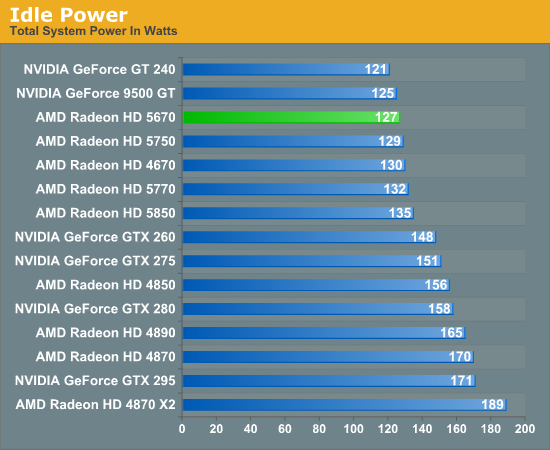
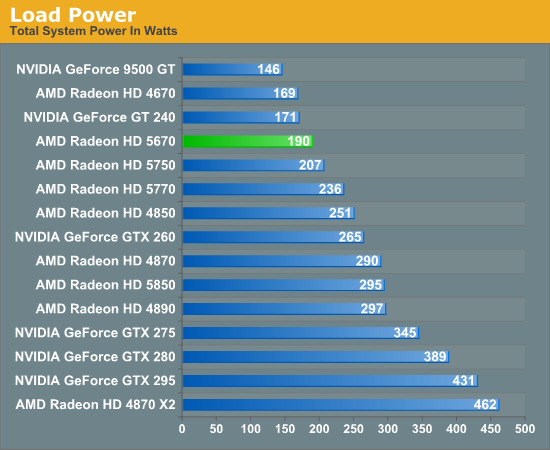
The one thing AMD can’t quite best the GT 240 at is idle power. Here the GT 240’s sub-10W idle means the 5670 idles slightly higher. With that said it’s the 3rd lowest card of all time, behind only the GT 240, and the significantly slower 9500 GT.
Load power paints a different picture however, and this is where the concept of a “power virus” pokes its head up again. The 5670 has a lower TDP than the GT 240 according to the specs published by AMD and NVIDIA - at 61W and 70W respectively - and we have no reason to doubt these numbers. But here the load power of the 5670 is much higher, by just shy of 20W. You’ll notice here that the 4670 is also much lower in spite of similar specs – all of this leads us to believe that the other cards are throttling themselves some as compared to the 5670, whose VRM protection features let it run away compared to these cards. Compared to the 5750 the data is correct, so that makes a better reference point than the GT 240 or 4670.
Accounting for these quirks, the 5670 should be between the 3rd and 2nd lowest power consuming card that we have on-hand.
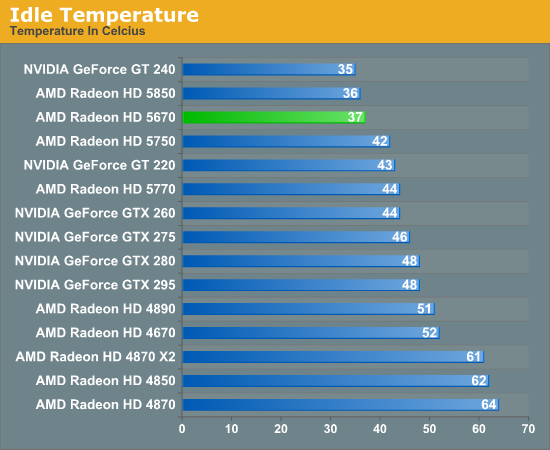
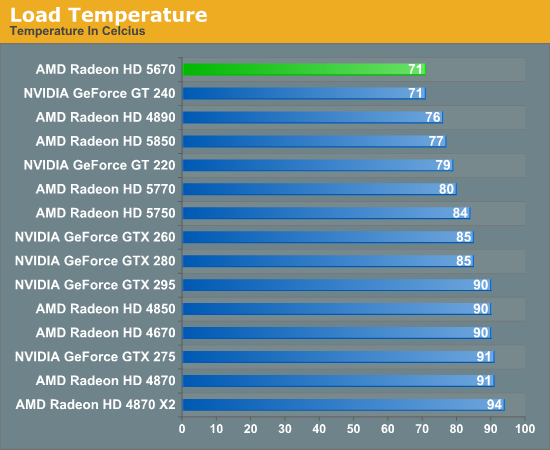
Less power usage leads to less heat, and in this case this means the 5670 once again trails the GT 240, which benefits from said lower power usage and the dual-slot cooler on our specific card. It’s still the 3rd best card however, beating everything except said GT 240 and the remarkably cool 5850.
At load, the picture looks very good for AMD. Even though we’re using a dual-slot cooler, thanks to the low load power usage we’re looking at a tie for the lowest load temperatures we’ve ever recorded. The dual-slot GT 240 ties at 71C, and we’re several degrees from anything else. The results are particularly good compared to the 4670, which was an inferno at 20C higher in this test.
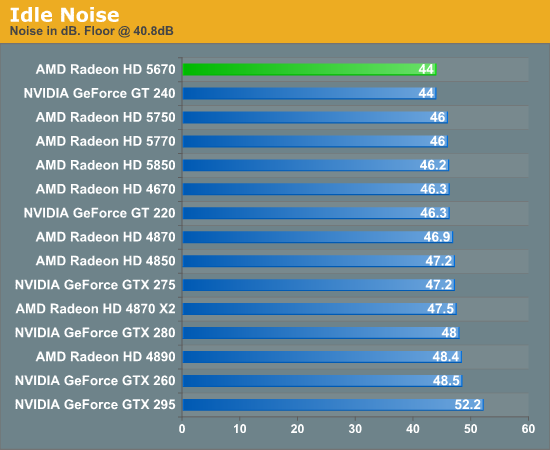
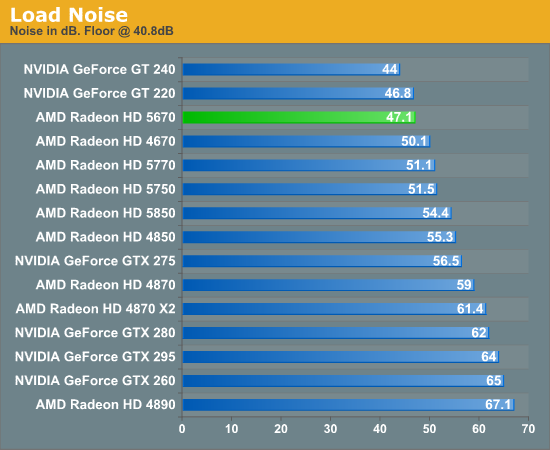
Finally there’s noise. As is the case with all of our other cards, the noise at idle is virtually indistinguishable from the noise generated by the rest of the computer.
At load the 5670 continues to be a quiet card, at only 3dB louder than idle. The only thing it falls behind here are the GT 220 and GT 240, both of which use dual-slot coolers and can afford the use of a larger, quieter fan. This is actually very impressive for a single-slot blower.
All of this data points to the 5670 making for a good HTPC card, certainly one as good if not better than the GT 200 series, and definitely better than the 4670. It’s cool and quiet, everything an HTPC card needs. However we’re more interested in where the 5500 series would place here – few HTPCs need this much rendering power, and with the 5500 series sub-50W power draw, it may be an even better choice.










73 Comments
View All Comments
Spoelie - Thursday, January 14, 2010 - link
Also, the conclusion that the radeon really pulls away from the other value cards at higher resolutions (hawx) might be an artifact of the differing memory sizes.(need edit button!)
kmmatney - Thursday, January 14, 2010 - link
I bought a $99 HD4830 more than a year ago, and it much faster than this, especially when overclocked (as it had lot of OC headroom, and performs a little faster than an HD4850). Sad that the same amount of money a year later gets you a slower card.Griswold - Thursday, January 14, 2010 - link
You 4830 is a partial defective 4850, thats what made it nice value until the 4770 arrived (despite low availablility then). You have to wait for the already rumored 5830 to get the same feeling again...BelardA - Thursday, January 14, 2010 - link
What made the 4670 an exciting card well over a year ago was that it was under $100 when it was launched ($80 avg) and it was almost as fast as the 3870, sometimes faster (as drivers matured). So when looking at some of these benchmarks that DON'T have the 4670, just look at the 3870 and count it the same. So at $80, it had replaced the $200~150 3870 and ran cooler, etc.Anyway, the 5670 SHOULD have at least equaled the 4770 in performance! That would make the 5670 a very good value gaming card for the $90~100 price range. You can get 4770s for about $95~110 (until gone).
Hopefully in the coming months, the prices will start to get lower
naturally. But AMD should have a $100 card that *IS* equal to the 4850. Perhaps that would be a 5730 card, but its power should still be under 75watts under load.
Until Nvidia comes out with something competitive, AMD has little reason to load the prices... ha, notice how things have changed? :)
Ideal pricing by March/April.
5870 = $350 (Today = $400~440)
5850 = $225 (Today = $300~340)
5830 = $175 * hey, there was a 4380, why not?
5770 = $125 (Today = $155~200 for 1GB)
5750 = $110 (Today = $135~150 for 1GB)
5730 = $ 95 * hey, there was a 4380, why not?
5670 = $ 75 * Its cheaper to make than a 4670.
5650 = $ 60
5550 = $ 55 * Cause 555 looks cool.
5450 = $ 40
5350 = $ 30 * Office PCs that need DVI... 4350s are $25.
With such a line up, the entire 4000 series can go. There are still 3600s and 24/2600s on the market, usually lo-profile or AGP.
In the meantime, Nvidia will still be selling 9600 / 9800 / GT1xx / G/gt 2xx for another 1-3 years... ugh.
BelardA - Thursday, January 14, 2010 - link
OOPS! I typoedI meant to say "4830", not "4380".... doh!
Drazick - Thursday, January 14, 2010 - link
What About Some Open CL / Direct Compute tests?No games, just pure calculations?
Thanks.
haplo602 - Thursday, January 14, 2010 - link
hmm seems this card is a bit short of my needs ... a performance level around hd4770 would be great.Obsy - Thursday, January 14, 2010 - link
Idle and Load Power charts say "NVIDIA GeForce 4870 X2" ;)MadMan007 - Thursday, January 14, 2010 - link
Nice thorough review. I'd be interested in some more results with lesser or no AA as well though. While we all love AA it's kind of silly to expect to run it well at 1920x1200 or sometimes even 1680x1050 on <$100 cards. Plus it would give those who keep cards for a long time and just turn down features such as AA a better comparison.ET - Thursday, January 14, 2010 - link
While I already replaced my 3870 with a 5750, it's nice to see a sub-$100 card that beats it in all cases. I'm glad ATI went with 128bit GDDR 5 for this card.